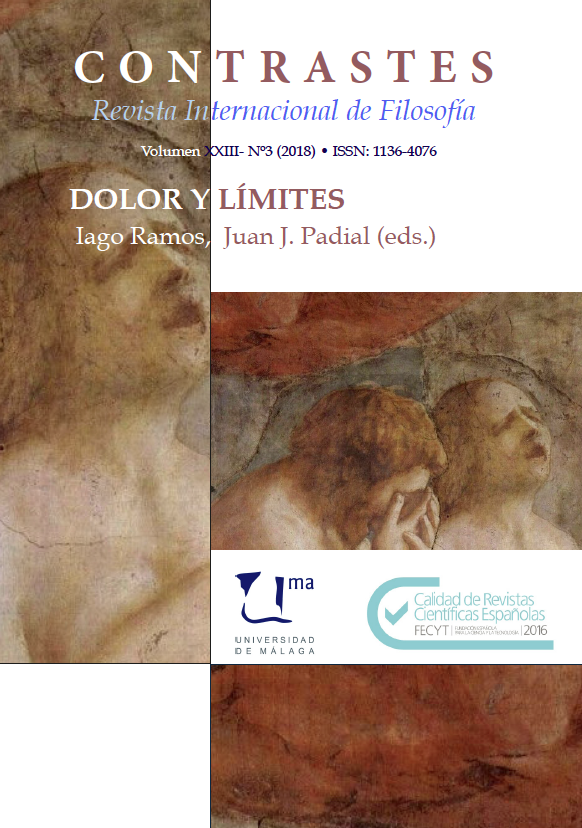Philosophical Prospect of Pain
DOI:
https://doi.org/10.24310/Contrastescontrastes.v23i3.6595Keywords:
Pain, suffering, philosophy of pain, science of pain, empathyAbstract
The aim of this paper is to discuss the odds of the philosophy to contribute in the understanding of pain. In section (1) we point out that pain is rooted in a subjective experience, so (2) knowing pain entails taking into account the individual experiences. Due to its nature, (3) we ought to rethink constantly the value of pain, as well as (4) how pain challenges science and philosophy. We conclude that pain requires to be challenged with empathy and collaboration. Thus, to the extent that we need to humanize the pain, a philosophy about it is meaningful to know pain.Downloads
Metrics
Publication Facts
Reviewer profiles N/A
Author statements
Indexed in
-
—
- Academic society
- N/A
- Publisher
- Universidad de Málaga
References
Aydede, Murat (2005) Pain. New Essays on Its Nature and the Methodology of Its Study. Cambridge: MIT Press.
Bain, David (2014) “Pains that don’t hurt”. En Australasian Journal of Philosophy, vol. 92, n. 2, pp. 305–320.
Barrett, Lisa F. (2006) “Are emotions natural kinds?”. En Perspectives on Psychological Science, vol. 1, n. 1, pp. 28–58.
Beck, Ulrich (2008) La sociedad del riesgo mundial: en busca de la seguridad perdida. Barcelona: Paidós.
Bonete, Enrique (2004) ¿Libres para morir? En torno a la Tánato-Ética. Bilbao: Declée de Brouwer.
Bourke, Joanna (2014) The Story of Pain: from Prayer to Painkillers. Londres: Oxford University Press.
Cervero, Fernando (2014) Understanding Pain. Cambridge: MIT Press.
Díaz Romero, Paula (2015) “Consideraciones sobre el dolor desde una perspectiva fenomenológica”. En Co-herencia vol. 12, n. 23 (julio-diciembre), pp. 89-106.
Giddens, Anthony (1995) Modernidad e identidad del yo: el yo y la sociedad en la época contemporánea. Barcelona: Península.
Goldie, Peter (2010) The Oxford Handbook of Philosophy of Emotion. Oxford: Oxford University Press.
Hyde, Alan (1997) Bodies of Law. Princenton: Princeton University Press.
Klein, Colin (2015) What the body commands. Londres: MIT Press.
Melzack, Ronald & Casey, Kenneth L. (1968) “Sensory, motivational, and central control determinants of pain: a new conceptual model”. En Dan Kenshalo (ed.) The Skin Senses: Proceedings. Springfield: C.C. Thomas, pp. 423–439.
Melzack Ronald & Wall Patrick D. (1965) “Pain mechanisms: a new theory”,. En Science, n. 150, pp. 971–979.
Moscoso, Javier (2012) Pain: a cultural history. Londres: Palgrave MacMillan.
Morin, Edgar (1984) Ciencia con conciencia. Barcelona: Anthropos.
Nussbaum, Martha (2003) La terapia del deseo. Teoría y práctica en la ética helenística. Barcelona, Paidós.
Panksepp, Jaak (2005) “On the Neuro-Evolutionary Nature of Social Pain, Support and Empathy”. En Murat Aydede (ed) Pain. New Essays on Its Nature and the Methodology of Its Study. Cambridge: MIT Press, págs. 367-387.
Ramos Arenas, J. (2001) “Las facetas de lo mental”. En Ideas y Valores, vol. 117 (diciembre), pp. 22-36.
Sarno, John E. (1999) The Mindbody Prescription: Healing the Body, Healing the Pain. New York: Grand Central Publishing.
Sarat, Austin (2014) Knowing the suffering of others: legal perspectives on pain and its meanings. Tuscaloosa: University of Alabama Press.
Stanghellini, Giovanni (1997) Antropologia della vulnerabilità. Milán: Feltrinelli.
Scarry, Elaine (1988) The Body in Pain. Oxford: Oxford University Press.
Tashani, Osama A. & Johnson, Mark I. (2010) “Avicenna’s concept of pain”. En Libyan Journal of Medicine, n. 5, p. 5253.
Vignemont, Frédérique & Jacob Pierre (2012) “What is like to Feel Another’s Pain?”. En Philosophy of Science, vol. 79, n. 2, pp. 295–316.
Wall, Patrick (2000) Pain: the science of suffering. New York: Columbia University Press.
Zubin, Joseph & Spring, Bonnie (1977) “Vulnerability: A new view of schizophrenia”. En Journal of abnormal psychology, vol. 86, n. 2, p. 103.
Downloads
Published
How to Cite
Issue
Section
License
This journal provides immediate free access to its content under the principle of making research freely available to the public. All content published in Contrastes. Revista Internacional de Filosofía, are subject to the Creative Commons Attribution-NonCommercial-ShareAlike 4.0 license whose full text can be found at <http://creativecommons.org/licenses/by-nc-sa/4.0>
It is the responsibility of the authors to obtain the necessary permissions of the images that are subject to copyright.
Authors whose contributions are accepted for publication in this journal will retain the non-exclusive right to use their contributions for academic, research and educational purposes, including self-archiving or repository in open access repositories of any kind.
The electronic edition of this magazine is edited by the Editorial Service of the University of Malaga (Uma Editorial), being necessary to cite the origin in any partial or total reproduction.










5.png)
